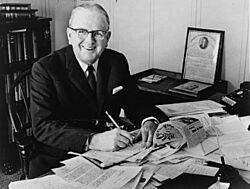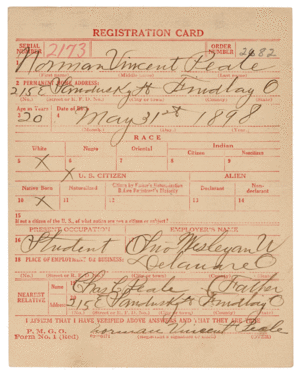Norman Vincent Peale facts for kids
Quick facts for kids
Norman Vincent Peale
|
|
|---|---|

Peale in 1966
|
|
| Born | May 31, 1898 Bowersville, Ohio |
| Died | December 24, 1993 (aged 95) Pawling, New York |
| Occupation | Author, speaker, Reformed Church in America minister |
| Nationality | American |
| Genre | Motivational |
| Subject | Positive thinking |
| Spouse |
Ruth Stafford
(m. 1930) |
Norman Vincent Peale (born May 31, 1898 – died December 24, 1993) was an American Protestant minister and author. He is most famous for making the idea of positive thinking popular. His best-selling book, The Power of Positive Thinking, was published in 1952.
Peale was the pastor of Marble Collegiate Church in New York City from 1932 until he retired in 1984. This church is part of the Reformed Church in America. Besides his work as a minister, he wrote many books, edited magazines, and had shows on radio and television.
He received the Presidential Medal of Freedom in 1984. This is the highest award a civilian can get in the United States. Peale passed away at age 95 in Pawling, New York. He was married to Ruth Stafford for 63 years. She helped him publish The Power of Positive Thinking and they started Guideposts magazine together in 1945.
Contents
Early Life and School
Norman Vincent Peale was born in Bowersville, Ohio, on May 31, 1898. He was the oldest of three sons. His father, Charles Peale, was a doctor who became a Methodist minister. So, Norman and his brothers grew up in the Methodist church.
Peale finished high school in Bellefontaine, Ohio, in 1916. He then went to Ohio Wesleyan University. After that, he studied at Boston University School of Theology to become a minister.
Norman Peale's Career
Starting His Ministry
While still studying, Peale filled in for a sick pastor in Ohio. His father told him to preach in a simple way, talking about Jesus Christ in a way that related to everyday life. People liked this simple style.
Later, Peale worked as a journalist for a short time. But he soon returned to his main goal: ministry. In 1922, he became a pastor in the Methodist Episcopal Church. His first church was in Rhode Island. Then, in 1924, he moved to a small church in Brooklyn. His work there helped the church grow a lot, and they built a new building.
In 1927, Peale became the pastor at University Methodist Church in Syracuse, New York. Here, he became one of the first ministers to share his sermons on the radio. This made him even more popular. He later used television in the same way.
During the Great Depression, Peale helped start an organization called 40Plus. This group aimed to help unemployed managers and executives find jobs.
Leading Marble Collegiate Church
In 1932, Peale was invited to lead the Marble Collegiate Church in New York City. This church is very old, dating back to 1628. To become their pastor, he had to change his church group to the Reformed Church in America.
When he started, only about 200 people attended services. But because of his lively sermons, thousands of people soon came to his church. Peale stayed at Marble Collegiate Church until he retired in 1984.
Working with Mental Health Experts
After the stock market crash of 1929, many people in his church had difficult problems. Peale's wife, Ruth, suggested he find a psychiatrist to help them. He met Smiley Blanton, a psychiatrist who believed that mental health and religion could work together.
Peale and Blanton wrote a book together called Faith Is the Answer: A Psychiatrist and a Pastor Discuss Your Problems (1940). This book had chapters written by both of them. In 1951, their work grew into the American Foundation of Religion and Psychiatry. Peale focused on religious issues, while Blanton helped with mental health cases.
However, when Peale's book The Power of Positive Thinking came out in 1952, some mental health experts criticized it. Blanton then kept his distance from Peale and did not publicly support the book.
Radio and Books
Peale continued his radio work in New York City in 1935. He wanted to reach as many people as possible with his message. His radio show, The Art of Living, became very popular and reached millions of listeners.
His first book from New York City, also called The Art of Living, came out in 1937. It talked about the power people have inside themselves. In 1945, after World War II, Peale, his wife Ruth, and a businessman named Raymond Thornburg started Guideposts magazine. This magazine shared inspiring stories.
In 1948, Peale had his first best-selling book, A Guide for Confident Living. This self-help book connected religion with solving personal problems. Then came his most famous book, The Power of Positive Thinking, published in 1952. His wife, Ruth, secretly sent the first draft to an editor. This book stayed on best-seller lists for over three years. It has sold millions of copies and has been translated into many languages.
Peale's radio program, The Art of Living, continued for 54 years. He also started doing television shows when the new medium became available. He kept writing books and editing Guideposts magazine.
Organizations He Founded
In 1947, Peale and educator Kenneth Beebe started The Horatio Alger Association. This group honors Americans who become successful despite facing tough challenges.
Peale also founded other organizations, including the Peale Center, the Positive Thinking Foundation, and Guideposts Publications. All these groups work to share Peale's ideas about positive thinking.
Personal Life
Norman Vincent Peale was friends with President Richard Nixon and his family. He even led the wedding ceremony for Nixon's daughter, Julie Nixon, and David Eisenhower in 1968. He continued to visit the White House during the Watergate scandal.
Peale was also a high-ranking member of the Freemasons, a fraternal organization.
Later Life
On March 26, 1984, President Ronald Reagan gave Peale the Presidential Medal of Freedom. This award recognized Peale's important work in theology.
Peale passed away at age 95 on December 24, 1993, in Pawling, New York, after having a stroke. He was survived by his wife, Ruth Stafford Peale, who lived to be 101 years old. She had a big influence on his work, including the publishing of The Power of Positive Thinking.
His Influence
Many important people were influenced by Norman Vincent Peale. Five U.S. presidents, including Richard Nixon, Gerald Ford, Jimmy Carter, Ronald Reagan, and George H. W. Bush, spoke highly of him in a documentary about his life.
The Reverend Billy Graham said that Norman and Ruth Peale had done a lot for their faith and had encouraged him greatly. Donald Trump and his family attended Peale's church when Donald was a child. Trump has often said that Peale was a very important influence on him.
Scott Adams, who created the comic strip Dilbert, also said that Peale's writings helped him achieve success. Peale also spoke to student leaders at MSOE University, influencing many future engineers and managers.
Selected Books
- The Positive Power of Jesus Christ (1980) ISBN: 0-8423-4875-1
- Stay Alive All Your Life (1957)
- Why Some Positive Thinkers Get Powerful Results (1987). ISBN: 0-449-21359-5
- The Power of Positive Thinking, Ballantine Books (1996). ISBN: 0-449-91147-0
- Guide to Confident Living, Ballantine Books (1996). ISBN: 0-449-91192-6
- Six Attitudes for Winners, Tyndale House Publishers (1990). ISBN: 0-8423-5906-0
- Positive Thinking Every Day : An Inspiration for Each Day of the Year, Fireside Books (1993). ISBN: 0-671-86891-8
- Positive Imaging, Ballantine Books (1996). ISBN: 0-449-91164-0
- You Can If You Think You Can, Fireside Books (1987). ISBN: 0-671-76591-4
- Thought Conditioners, Foundation for Christian (1989). ISBN: 99910-38-92-2
- In God We Trust: A Positive Faith for Troubled Times, Thomas Nelson Inc (1995). ISBN: 0-7852-7675-0
- Norman Vincent Peale's Treasury of Courage and Confidence, Doubleday (1970). ISBN: 0-385-07062-4
- My Favorite Hymns and the Stories Behind Them, HarperCollins (1994). ISBN: 0-06-066463-0
- The Power of Positive Thinking for Young People, Random House Children's Books (1955). ISBN: 0-437-95110-3
- The Amazing Results of Positive Thinking, Fireside (2003). ISBN: 0-7432-3483-9
- Stay Alive All Your Life, Fawcett Books (1996). ISBN: 0-449-91204-3
- You Can Have God's Help with Daily Problems, FCL (1956–1980)
- Faith Is the Answer: A Psychiatrist and a Pastor Discuss Your Problems, Smiley Blanton and Norman Vincent Peale, Kessinger Publishing (2007). ISBN: 1-4325-7000-5
- Power of the Plus Factor, Fawcett Crest Book (1987). ISBN: 0-449-21600-4
- This Incredible Century, Peale Center for Christian Living (1991). ISBN: 0-8423-4615-5
See also
 In Spanish: Norman Vincent Peale para niños
In Spanish: Norman Vincent Peale para niños


